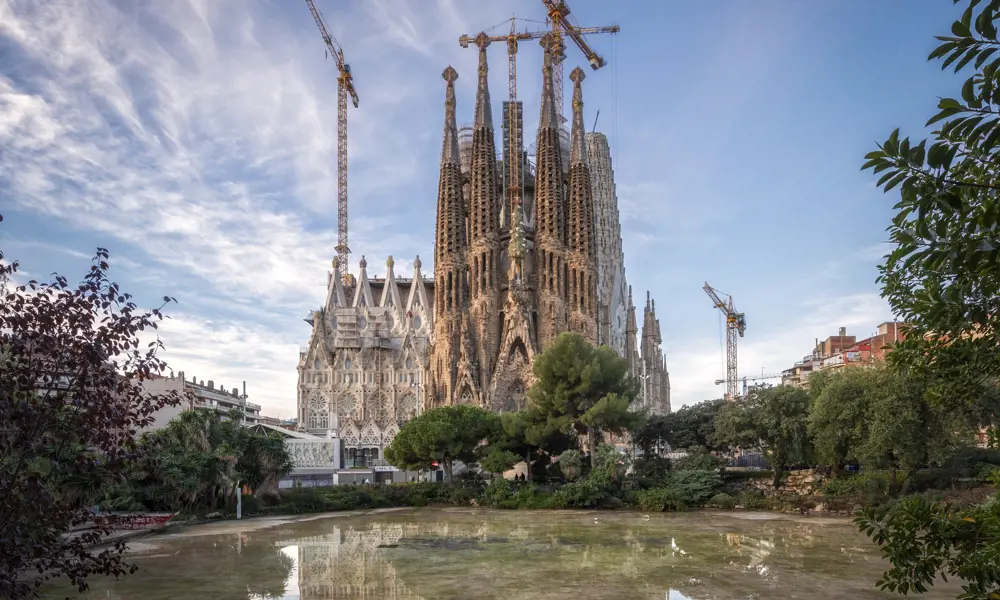
Completing the Sagrada Família
Arup was called in to collaborate with the Sagrada Família Foundation and its well-established team of in-house architects and builders in 2014, initially with one particular challenge: one of the 18 towers – the Mary Tower over the crypt – was going to weigh too much for the foundations installed in 1877, and some fresh ideas were needed. How could a tower be designed and built that would work both structurally and visually, while following the guidelines that Gaudí had set, and maintaining the highest quality? An earlier idea had been to erect an interior steel structure on which stonework could be hung, but this was seen as inappropriate.
Meanwhile other factors were at work. The trickle of donations to fund construction had turned into a torrent, as Barcelona’s booming tourist industry brought more paying visitors, particularly after the completion of the nave and consecration of the church by Pope Benedict in 2010 – there are currently some four million visitors per year. A major constraint on the speed of construction had been removed, and the bold decision had been taken to complete the structure (but not necessarily the decoration) by 2026. This required a tenfold increase in the speed of construction compared to the previous 130 years.
Another element to consider was that traditionally all construction work for the church had been done on the site, which was becoming cramped as the building expanded. It was also becoming unmanageable, as the pace of construction (and hence the workload) increased, and the church was still having to remain open for its many visitors. The case for off-site fabrication was strong.
3D modelling and stress levels under different loading conditions
The first action was to determine the shape of the tower. No models or drawings of the Mary Tower survived, so a design had to be recreated from fragmentary archival evidence and by extrapolating from Gaudí’s use of geometry in his model for the sacristy. A series of hyperbolic paraboloids were rotated about a central axis and intersected. This was then modelled in Rhino 3D software and elongated to create a tower with a scalloped multi-sided shape in plan, with many small triangular windows, shaped as hyperboloids.
Next a structural form was needed. Various ideas were conceived, modelled in Rhino and then tested by finite element analysis to reveal the stress levels in each element under different loading conditions. Earthquake loading was important, but in most cases the critical condition was under extreme wind loading. Each idea was tested at various levels of computer analysis, starting with the ‘quick and dirty’ and moving swiftly to the highly detailed.
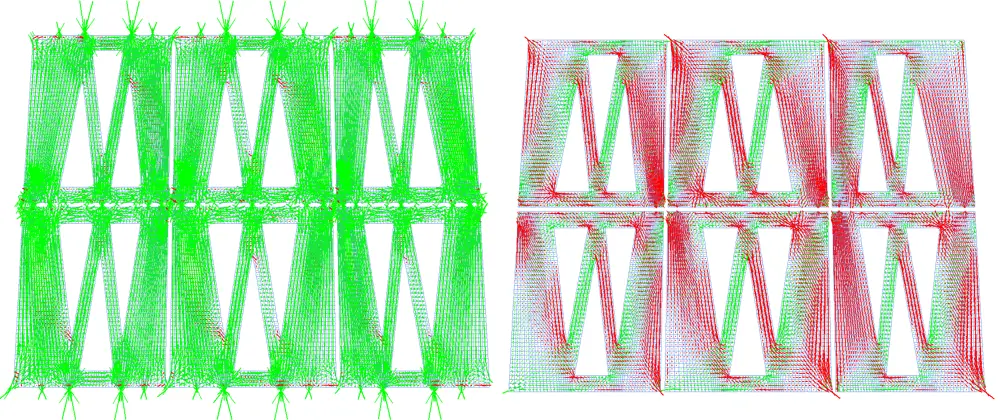
Stress analysis of a section of the Mary Tower under extreme wind loading, showing large areas in tension (red) using traditional masonry), compared with almost all in compression (green) with prestressed masonry panels © Arup
As a start, Arup modelled what would happen if the tower was built in traditional stone masonry (thin enough to be within the weight that could be carried by the foundations). Under normal loading the tower behaved reasonably well but under extreme wind loads all parts of the masonry facing the wind went into tension. As traditional masonry is very strong in compression but very weak in tension this approach would not work.
After further modelling a potential solution was proposed. Instead of using traditional construction, what if the masonry was pre-formed in larger panels and prestressed using tensioned steel rods before erection? In this way, the masonry could be pre-compressed so that it would be much less likely to go into tension under wind loading. Panels around 4 metres high by 3 metres wide, 14 to a ring of the Mary Tower and weighing around 5 tonnes each would suit the geometry and be reasonably easy to create and erect. The panels could then be simply bolted together, with shear connectors on the horizontal joints.
Careful design of connections combined with precise manufacture ensured that the panels when craned into position could fit together like Lego blocks, with no on-site adjustment

A prototype column, showing the stainless steel rods threaded through the drilled masonry, and the anchorage plates for prestressing © Arup
Finite element analyses demonstrated that this strategy could work. Under extreme wind loading, almost all elements of the panels remained in compression, though there were some elements that could move into tension (red, in the diagram), which could then lead to a crack forming in the masonry. The question then was whether the crack would open up with serious consequences or whether the loads would redistribute safely in the remaining structure: a simple re-run of the analysis removing the element in tension, confirmed the latter.
The prestressed masonry panels had the additional advantages that they retained the use of Gaudí’s preferred sandstone as the primary structural material, they were ideally suited to off-site construction, and they achieved the necessary weight reduction: the stone in the panels is just 300 millimetres thick, compared with around 1.2 metres for traditional masonry, and resulted in a structure just light enough for the foundations.
Once the overall form was determined, the team modelled every component of each panel to a construction level of detail, including nuts, bar threads, couplers, fillets and chamfers. In this they were assisted by full-scale mock-ups produced by the Foundation, to check appearance, and for ‘buildability’. Every detail was carefully planned, and a kit of parts assembled including the stainless steel rods and bolts for the prestressing. Careful design of connections combined with precise manufacture ensured that the panels when craned into position could fit together like Lego blocks, with no on-site adjustment.
Antoni Gaudí - architect and engineer
⛪ Extrapolating from Gaudí’s use of geometry to design the church
Antoni Gaudí was in his early thirties when he took over as architect for the Sagrada Família, before his modernist buildings in Barcelona had established his reputation. His appointment followed the resignation in 1883 of his predecessor, with the stone crypt of a neo-Gothic church already nearly complete.
Gaudí spent the next 43 years developing his own distinctive design for a far larger and different structure, in his later years working exclusively and obsessively on the church, driven by his profound Catholic faith. He never expected the church to be completed in his lifetime, and as he once famously observed: “My client is not in a hurry”. Besides, construction was funded by private donations and could proceed no faster than the flow of money.
But he left plenty of clues as to how it should be finished. He completed the crypt, the façade of the apse and just one of the planned 18 towers, plus much of the Nativity entrance – which served as examples. He also left extensive drawings and plaster models. An explosion during the Spanish Civil War destroyed or extensively damaged many of the drawings and models, though much has been recovered by painstaking restoration. Where models exist, the current design team follow them exactly. Where only drawings or fragments of model remain, the team uses a degree of interpretation, complicated by the changes in Gaudí’s thinking (and drawings) during his lifetime. Where there is no evidence, they can freely interpret his intentions.
In his later years, Gaudí became fascinated with geometry, and he designed much of the masonry structure and the whole of the interior of the church and its ornate decoration using just two key figures: the hyperboloid, a little like a three-dimensional hour-glass, and the hyperbolic paraboloid, the saddle-shape of a Pringles potato chip. Complex shapes curved in three dimensions can be created from either figure, but both have one interesting feature in common: they have ruled surfaces, which means it is possible to draw a straight line along the surface through any point. Though Gaudí cannot have anticipated it, this feature provides an extraordinary advantage to 21st-century engineers trying to replicate and construct his designs: any of his shapes can be modelled in 3D software, and then cut using robot operated, computer-controlled diamond band-saws or lasers, to high degrees of precision.
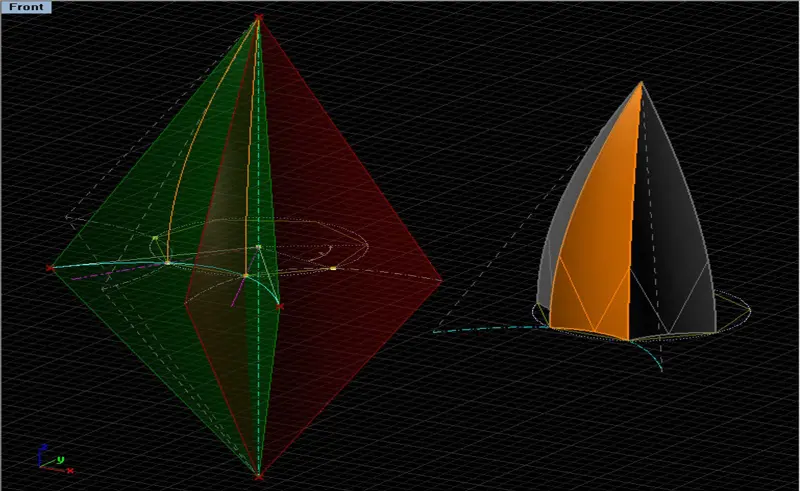
Resolving the geometry. The shape of the Sacristy, created by rotating a series of hyperbolic paraboloids about a central axis © Fundació Junta Constructora del Temple de la Sagrada Família
Off-site preparations and production
Meanwhile a suitable fabrication site was found north of Barcelona, some 90 minutes from the church. Here the digital model was used to automatically cut the stone, with its angled jointed surfaces finished to within 1 millimetre by computer-controlled cutting. A more traditional method was used to match the rest of the church with the outer finish of naturally broken sandstone: the edges were hit very hard with a sledgehammer.
Then the individual stone blocks were fabricated into a panel using laser-cut plywood templates, and prestressed with machined duplex stainless steel bars, inserted through holes predrilled through the masonry. Finally the holes were grouted, to provide further long-term protection to the steel rods.
In this way a production line was formed. Each of the 14 panels in a ring was identical, so there was helpful repetition, but as the tower is tapering, each successive ring was smaller as the tower rose. It took a month to fabricate each ring, but then only a day to assemble it on site: the care taken in design and the accuracy of manufacture meant that the panels slotted together rapidly with a minimum of fuss, so minimising both the use of limited crane access at the church and disturbance to church activities and its visitors.
The principle of prestressing masonry panels and the off-site production method have been adopted for construction of the remaining towers, in particular, the tallest of all, the mighty Jesus Tower that sits above the crossing of the nave. Before Arup’s arrival, the plan had been to build the tower in reinforced concrete and clad it in stone. But experience with the Mary Tower demonstrated that prestressed masonry panels would not only be more appropriate, but also easier and faster to build.
Catenary curves
💡 The curved solution to flood the church with natural daylight
One of Gaudí’s objectives was to avoid a characteristic feature of Gothic churches – the flying buttress – that carries to the ground the lateral forces from the vaulted ceiling. These he believed to be unsightly ‘props’, not integral to the church. More importantly, they block the light entering the building, and Gaudí was determined to have the interior of his church flooded with natural daylight.
For a solution he turned to the catenary – the natural shape found by a chain hanging loosely between two supports. Invert the catenary, and you have an arch that will convey its weight to the ground with no transverse forces. If you then ‘distort’ the catenary by adding weights to represent the additional masonry that the arch will have to support, you create a shape that requires no buttresses.
Gaudí produced elaborate models, with bags containing lead shot attached to his chains, in order to discover the perfect shape. The result can be seen in the nave of the Sagrada Família, which was eventually completed and opened in 2010: the stone columns, viewed in cross-section looking down the nave, are Gaudí’s catenaries, with no verticals. The exceptions are the four vertical columns of the crossing, which will support a massive tower above.
Gaudí compromised in that his catenaries were only used in two dimensions: viewed in long-section, the columns are all completely regular and conventionally vertical.
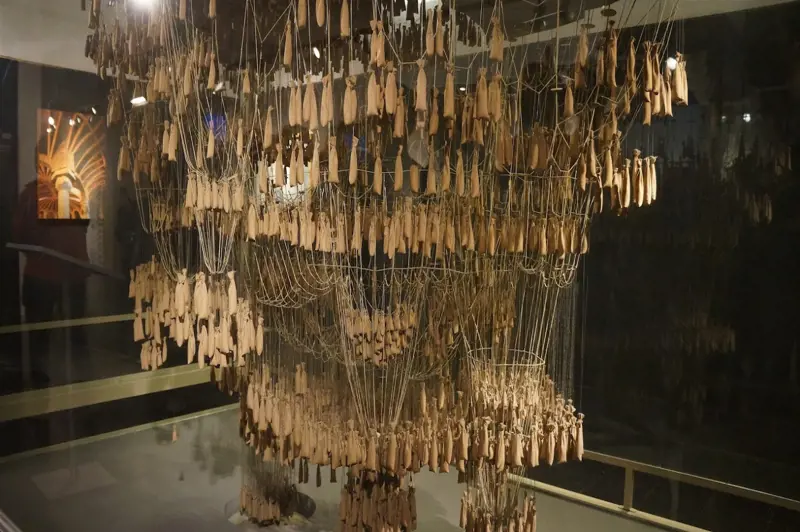
An upside-down force model of the Colònia Güell in the Sagrada Família Museum. Gaudí would hang strings and weights then use the resulting ‘catenary curve’ to model columns and arches. He would render the model upright by placing a mirror underneath or by taking a photograph © Fundació Junta Constructora del Temple de la Sagrada Família
Completing the towers
Construction started in July 2019 and the process has been identical to the Mary Tower except on a larger scale: the masonry thickness is 450 millimetres instead of 300 millimetres, there are 12 panels per ring instead of eight and each panel weighs 25 tonnes instead of 5 tonnes. When the Jesus Tower is ‘topped off’ with its five-armed cross, the Sagrada Família will be (at 172.5 metres) the world’s tallest church and Barcelona’s tallest building.
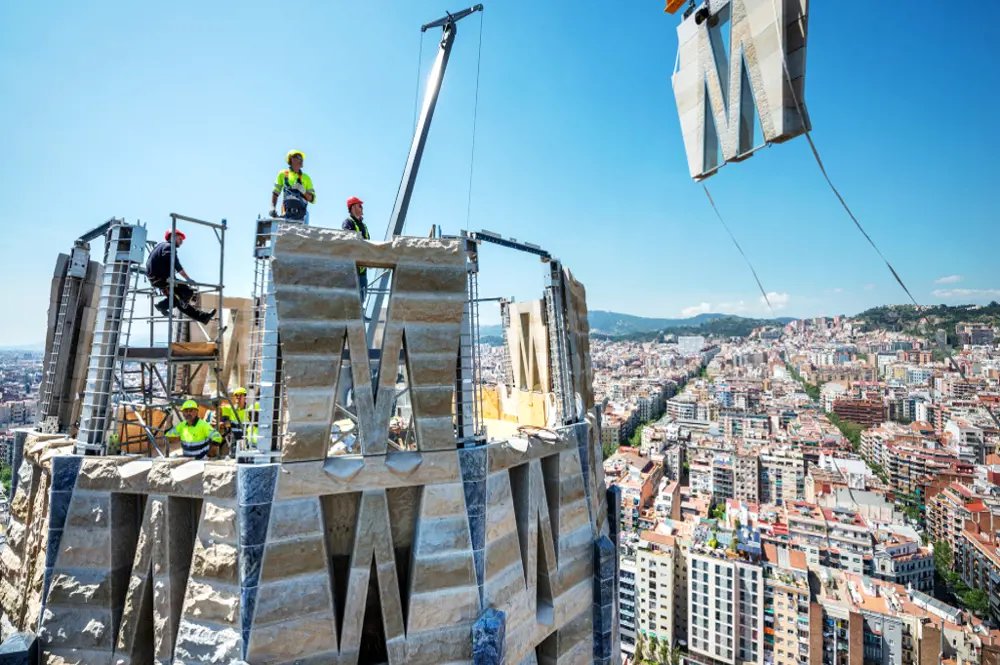
Lifting and placing a 25-tonne prestressed masonry panel for the Mary Tower high above the Barcelona skyline © Fundació Junta Constructora del Temple de la Sagrada Família
Inside the Jesus Tower a lift and staircase will carry visitors up into the cross. The spiral stone staircase will be cantilevered from the inside of the stone-panel wall, following a long tradition in masonry architecture. In this case, there is the added complication that the staircase has to span some of the openings in the tower: the solution, again, is to post-tension the stone to allow the staircase to bridge the gaps. The lift shaft will then be assembled up the middle of the tower.
When the Jesus Tower is ‘topped off’ with its five-armed cross, the Sagrada Família will be (at 172.5 metres) the world’s tallest church and Barcelona’s tallest building
Tristram Carfrae is well used to working closely with architects and builders worldwide, but never before has he experienced such close collaboration – due in part to the long-established in-house architect/builder team and in part to the simple, shared objective: to build the best church in the world. “It just makes me inordinately happy, and fulfilled, and pleased that I became a structural engineer to get to work on things like this.”
For more information about the project see www.arup.com/sagrada-familia
***
This article has been adapted from "Completing the Sagrada Familia", which originally appeared in the print edition of Ingenia 81 (December 2019).
Contributors
Tristram Carfrae RDI FREng is a structural engineer and Deputy Chairman of Arup. He has been responsible for the design and structure of many award-winning buildings during his 37 years with the firm, both in Australia and the UK. In 2014 he was awarded the prestigious Gold Medal award by the Institution of Structural Engineers and in 2018 he became the fourth Briton to receive the IABSE’s International Award of Merit in Structural Engineering.
Keep up-to-date with Ingenia for free
SubscribeRelated content
Civil & structural

Building the Shard
The Shard is one of London's most iconic buildings. The tallest in Western Europe, it was designed by Italian architect Renzo Piano and dominates the city’s skyline. Ingenia spoke to John Parker, project director for structural engineers WSP, who outlined the engineering decisions made in building the enormous steel and glass structure.
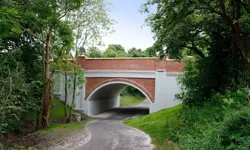
The return of arched bridges
Arch bridges are strong, durable and require little maintenance. However, very few had been built since the early 1900s until the FlexiArch was developed and launched in 2007. Now, there has been a minor renaissance for this ancient form of construction.

Creating user-friendly buildings
For Michelle McDowell, a former Business Woman of the Year, a passion for joined-up design thinking and building information modelling with a user-friendly approach has enabled her to pioneer revolutionary changes in her field.
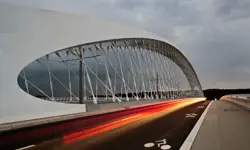
Troja Bridge
In November 2014, one of the world’s largest network arch bridges was officially opened in Prague. The UK may soon have its first network arch bridge if the go-ahead is given for a new rail project in Manchester.
Other content from Ingenia
Quick read

- Environment & sustainability
- Opinion
A young engineer’s perspective on the good, the bad and the ugly of COP27

- Environment & sustainability
- Issue 95
How do we pay for net zero technologies?
Quick read

- Transport
- Mechanical
- How I got here
Electrifying trains and STEMAZING outreach

- Civil & structural
- Environment & sustainability
- Issue 95